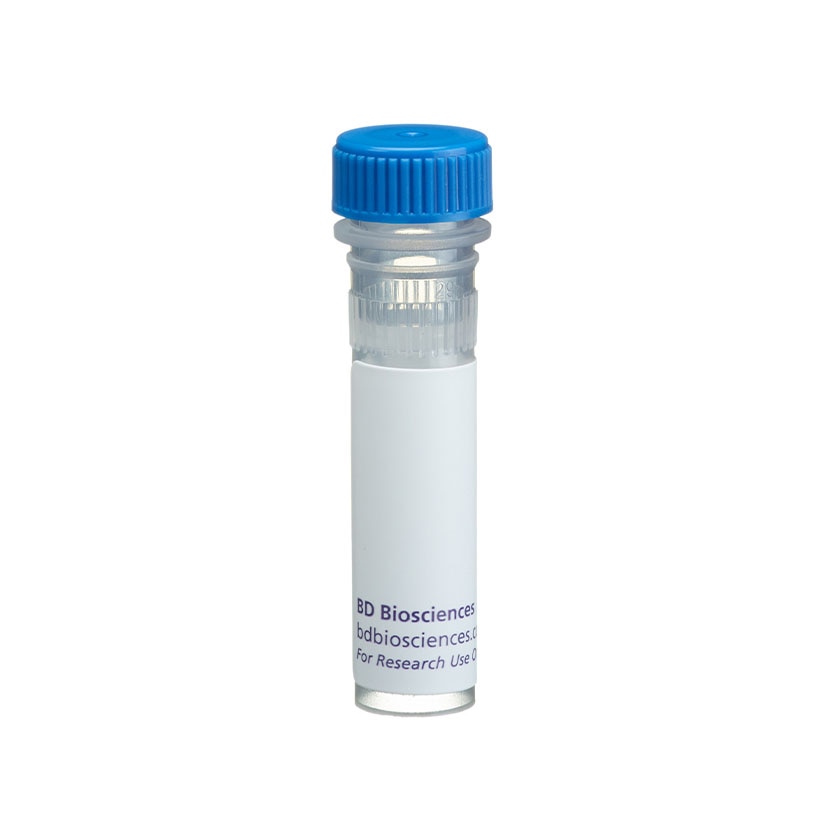-
Reagents
- Flow Cytometry Reagents
-
Western Blotting and Molecular Reagents
- Immunoassay Reagents
-
Single-Cell Multiomics Reagents
- BD® OMICS-Guard Sample Preservation Buffer
- BD® AbSeq Assay
- BD® Single-Cell Multiplexing Kit
- BD Rhapsody™ ATAC-Seq Assays
- BD Rhapsody™ Whole Transcriptome Analysis (WTA) Amplification Kit
- BD Rhapsody™ TCR/BCR Next Multiomic Assays
- BD Rhapsody™ Targeted mRNA Kits
- BD Rhapsody™ Accessory Kits
- BD® OMICS-One Protein Panels
- BD OMICS-One™ WTA Next Assay
-
Functional Assays
-
Microscopy and Imaging Reagents
-
Cell Preparation and Separation Reagents
Old Browser
This page has been recently translated and is available in French now.
Looks like you're visiting us from {countryName}.
Would you like to stay on the current location site or be switched to your location?
BD Pharmingen™ Purified Mouse Anti-Bax
Clone 6A7 (RUO)




Western blot analysis of Bax. Lysates from Daudi human B cells (lane 1) and mouse thymocytes (lane 2) were probed with anti-Bax (clone 6A7, Cat. No. 556467) Clone 6A7 identifies Bax as an ~21 kDa band.



Regulatory Status Legend
Any use of products other than the permitted use without the express written authorization of Becton, Dickinson and Company is strictly prohibited.
Preparation And Storage
Recommended Assay Procedures
Applications include western blot analysis (1-2 µg/ml) and immunoprecipitation. Daudi B lymphoma cells (ATCC CCL-213) and rat thymocytes are suggested as positive controls for western blot analysis. Due to low level of Bax expression in Hela cells, we do not recommend Hela as a positive control.
Product Notices
- Since applications vary, each investigator should titrate the reagent to obtain optimal results.
- Please refer to www.bdbiosciences.com/us/s/resources for technical protocols.
- Caution: Sodium azide yields highly toxic hydrazoic acid under acidic conditions. Dilute azide compounds in running water before discarding to avoid accumulation of potentially explosive deposits in plumbing.
The Bcl-2 family members are involved in mediating programmed cell death or apoptosis, and share two highly conserved functional regions, Bcl-2 homology 1 and 2 (BH1 and BH2). Several of the family members including Bcl-2 act as inhibitors of apoptosis, whereas others such as Bax promote cell death. It is thought that protein-protein interactions between Bcl-2 family members play an important role in their function. For example, Bax may form homodimers or heterodimers with either Bcl-2 and Bcl-XL (long). Bax homodimers is thought to promote cell death, whereas Bax heterodimerization with either Bcl-2 and Bcl-XL appears to block cell death. When Bax is present in excess, it can counteract the ability of Bcl-2 to inhibit cell death. Bax expression has been identified in a variety of tissues, including lung, stomach, kidney, thymus, lymph nodes, bone marrow, spleen, heart, exocrine pancreas, and brain. Liver, kidney, and the exocrine pancreas have been found to contain little or no Bcl-2. The Bax gene potentially encodes three different proteins Bax-α (21 kDa), Bax-β (24 kDa) and Bax-γ (5 kDa). Bax-α is the most common transcript.
The 6A7 antibody recognizes human, mouse and rat Bax. The 6A7 antibody reacts with an epitope between amino acids 12-24 of Bax, and studies suggest that this epitope may be in the vicinity of the dimerization domain of Bax. It has been proposed that the 6A7 antibody may directly compete with either Bcl-2 or Bcl-XL for binding to Bax. In western blots, the 6A7 antibody typically detects Bax as a single band of 21-22 kDa, thought to be Bax-α.
Development References (6)
-
Hsu YT, Wolter KG, Youle RJ. Cytosol-to-membrane redistribution of Bax and Bcl-X(L) during apoptosis. Proc Natl Acad Sci U S A. 1997; 94(8):3668-3672. (Clone-specific: Western blot). View Reference
-
Hsu YT, Youle RJ. Nonionic detergents induce dimerization among members of the Bcl-2 family. J Biol Chem. 1997; 272(21):13829-13834. (Clone-specific: Western blot). View Reference
-
Krajewski S, Krajewska M, Shabaik A, Miyashita T, Wang HG, Reed JC. Immunohistochemical determination of in vivo distribution of Bax, a dominant inhibitor of Bcl-2. Am J Pathol. 1994; 145(6):1323-1336. (Biology). View Reference
-
Oltvai ZN, Milliman CL, Korsmeyer SJ. Bcl-2 heterodimerizes in vivo with a conserved homolog, Bax, that accelerates programmed cell death. Cell. 1993; 74(4):609-619. (Biology). View Reference
-
Reed JC. Bcl-2 and the regulation of programmed cell death. J Cell Biol. 1994; 124(1-2):1-6. (Clone-specific). View Reference
-
Yin XM, Oltvai ZN, Korsmeyer SJ. BH1 and BH2 domains of Bcl-2 are required for inhibition of apoptosis and heterodimerization with Bax. Nature. 1994; 369(6478):321-323. (Biology). View Reference
Please refer to Support Documents for Quality Certificates
Global - Refer to manufacturer's instructions for use and related User Manuals and Technical data sheets before using this products as described
Comparisons, where applicable, are made against older BD Technology, manual methods or are general performance claims. Comparisons are not made against non-BD technologies, unless otherwise noted.
For Research Use Only. Not for use in diagnostic or therapeutic procedures.